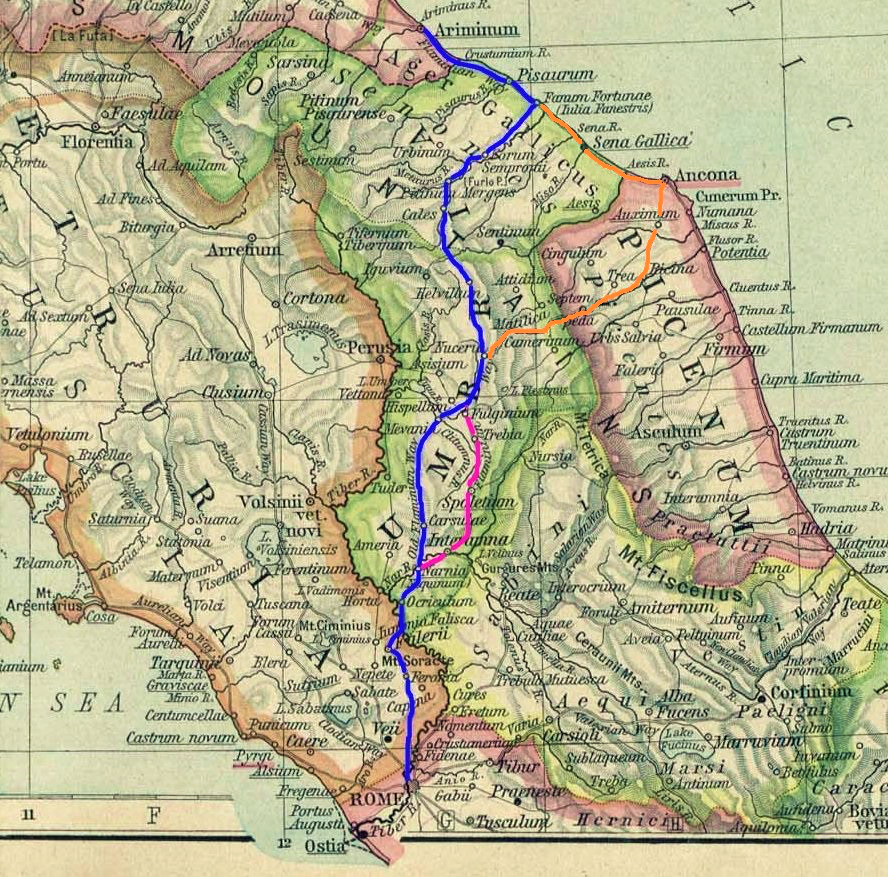
Main Via Flaminia in blue, later central alternative in pink and ‘branch line’ (Via Septempeda) in orange (CC licence source EH101)
‘All roads lead to Rome‘.
Actually, a fair number do, but it seems the saying wasn’t recorded as being coined by the Romans themselves. Of course, the Romans may well have said it and somebody may have written it down, but that written record, if it existed, has been lost.
The saying derives from medieval Latin. It was first recorded in writing in 1175 by Alain de Lille, a French theologian and poet, whose Liber Parabolarum renders it as ‘mille viae ducunt homines per saecula Romam‘ (a thousand roads lead men forever to Rome). The first documented English use of the proverb occurs more than two hundred years later, in Geoffrey Chaucer’s Astrolabe of 1391, where it appears as ‘right as diverse pathes leden diverse folk the righte way to Rome.‘
Anyway, the Via Flaminia most certainly did lead to Rome right into the city as the Via Lata and became today’s Via del Corso. Today, the Corso, as it’s known colloquially, is a popular place for the passeggiata, the evening stroll for people to be seen and to see others well as being an important shopping street for tourists and locals alike.
The Via Flaminia was first built in 220 BC when Gaius Flaminius was censor, hence the name; it was to be a new road to link Rome with the Adriatic Sea in the north. The starting point was the Porta Fontinalis, a gate in the Servian city walls near present-day Piazza Venezia. The new Via Flaminia cut through the plain between the Tiber and the eastern hills in a straight line. (A typical Roman road, then. 😉 ) The Campus Martius (Field of Mars) was at that time used as a training ground and pasture but numerous tombs must have lined the road in a similar way they did the Appian Way.
That inveterate builder and improver, Augustus (and probably his henchman Agrippa), instituted a general restoration of the roads of Italy, assigning supervision of different regions to various senators. He reserved the Flaminia for himself and rebuilt all the bridges except the Pons Mulvius (known to us as the Milvian Bridge) by which it crosses the Tiber, 3 kilometres (2 miles) north of Rome (built by Marcus Aemilius Scaurus in 109 BC).
The open area outside the Servian walls became increasingly urbanised during the late Republican and early imperial ages. The city gradually spread towards north and monumental public buildings were built along the road: the most important include Aurelian’s Temple of the Sun, the Ara Pacis, the Ustrinum Domus Augustae, the Ara Providentiae and the Column of Marcus Aurelius. The biggest and tallest of them was the Mausoleum of Augustus.
With the building of the Aurelian Walls (271-75 CE) the whole area was incorporated into the city of Rome, and a new city gate, the Porta Flaminia, was erected at present-day Piazza del Popolo.
The Via Lata (‘Broad Way’) which connects the Capitoline to the city gate, can be considered the urban stretch of the Via Flaminia. Its name tells us that the street was considered wide, especially in comparison to neighbouring lanes but in narrowed in three places along its length due to triumphal arches; the Arch of Claudius (51-52 CE) (the Aqua Virgo aqueduct crossed the road on top of it), the Arch said to be of Hadrian, later known as the Arco di Portogallo and the Arcus Novus erected by Diocletian in 303-304 CE.
Where did the Flaminia go after it left Rome?
The ancient Roman road led from Rome over the Apennine Mountains to Ariminum (Rimini) on the coast of the Adriatic Sea, and due to the ruggedness of the mountains was the major option the Romans had for travel between Etruria, Latium, Campania, and the Po Valley.
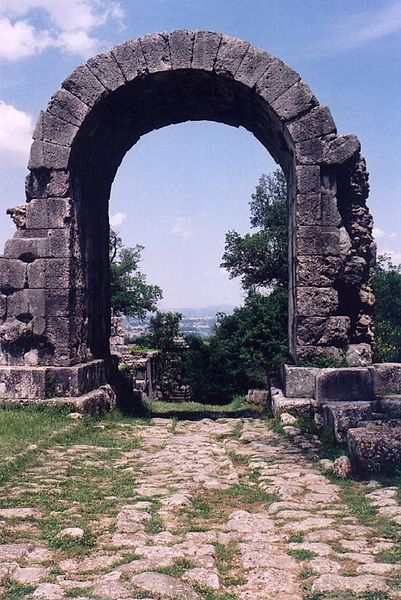
Arch of Trajan and Via Flaminia at Carsulae (CC licence, source: Imcarthur)
For my new novel, I was particularly interested in the part of the Via Flaminia between Rome and Ancona on the Adriatic coast. The road runs due north out of Rome, passing slightly east of the site of the Etruscan Falerii (today’s Civita Castellana), crossing the Tiber into Umbria over a bridge where you can still see some traces – the ‘Pile d’Augusto’. From there the Flaminia made its way to Ocriculum (Otricoli) with its fabulous baths complex and Narnia (Narni). (Yes, Narnia! C.S Lewis is supposed to have taken the Roman name as inspiration the setting of his children’s stories…)
Anyway, at Narnia, the road crossed the Nera River by the Ponte d’Augusto, the largest Roman bridge ever built, a splendid four-arched structure to which Martial, no less, mentions. One arch is still standing; another forms part of a modern railway tunnel.
Moving on, the Flaminia proceeded to Casuentum (San Gemini) which passed over two (finely preserved) ancient bridges, through Carsulae (a wonderful undisturbed site) to the Vicus Martis Tudertium (near modern Massa Martana), then Mevania (Bevagna) and Forum Flaminii (S. Giovanni Profiamma).
Later, a more circuitous route from Narnia to Forum Flaminii was adopted, increasing the distance by 12 Roman miles (18 km) and passing by Interamna Nahars (Terni), Spoletium (Spoleto) and Fulginium (Foligno) — from which a branch diverged to Perusia (Perugia). That was the slower option so my characters don’t take it – they go for the original hilly route.
From Forum Flaminii, where the two branches rejoined, the Flaminia went on to Nuceria Camellaria (Nocera Umbra) and my characters travelled along the branch road, the Via Septempeda which ended (or started in their case) at Ancona.
If it ain’t broke, don’t fix it
Today, the route, still called by the same name for much of its distance, is paralleled or overlaid by Strada Statale (SS) 3, also called Strada Regionale (SR) 3 in Lazio and Umbria, and Strada Provinciale (SP) 3 in Marche. Very useful for following on Google Maps and for using satellite view to get an idea of the countryside my characters travel through!
I’m fascinated that the route is practically the same over 2,000 years since the first foundations were laid. During the period of Roman expansion in the 3rd and 2nd centuries BCE, the Flaminia became a main axis for transporting wheat from the Po valley to supply Rome and central Italy. In most of the Roman period, including the end, the Flaminia was the main road leading into the heartland of Italy and like all Roman roads, the way of moving troops quickly and efficiently. Gaius Julius Caesar may have taken advantage of it at the beginning of the civil war, but various Germanic military forces and Byzantine generals found it a vital route hundreds of years later.
A number of major battles werefought on or near the Via Flaminia, for example at Sentinum (near the modern Sassoferrato) and near Tadinum (the modern Gualdo Tadino). Constantine the Great’s famous Battle of the Milvian Bridge occurred along the the Flaminia after his nearby dream of the Chi Rho which led to his conversion – and that of the Roman Empire – to Christianity.
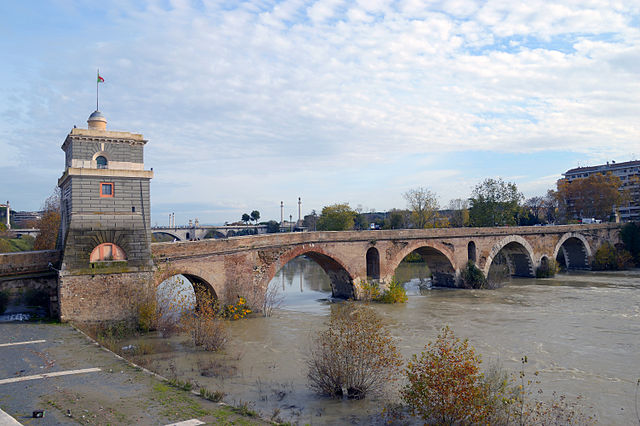
Milvian Bridge (Photo CC Licence, source: Livioandronico2013)
This route, once convenient to Roman citizens and other travellers, is now congested by heavy traffic between northern Italy and the capital in Rome. It remains an important road, but traffic now also reaches Rome by rail and autostrade using dozens of tunnels – shorter, more direct routes under the ridges and passes that their ancestors had to toil over.
Alison Morton is the author of Roma Nova thrillers – INCEPTIO, CARINA (novella), PERFIDITAS, SUCCESSIO, AURELIA, NEXUS (novella), INSURRECTIO and RETALIO, and ROMA NOVA EXTRA, a collection of short stories. Audiobooks are available for four of the series. Double Identity, a contemporary conspiracy, starts a new series of thrillers. Double Pursuit, the sequel, is now out!
Download ‘Welcome to Alison Morton’s Thriller Worlds’, a FREE eBook, as a thank you gift when you sign up to Alison’s monthly email update. You’ll also be among the first to know about news and book progress before everybody else, and take part in giveaways.




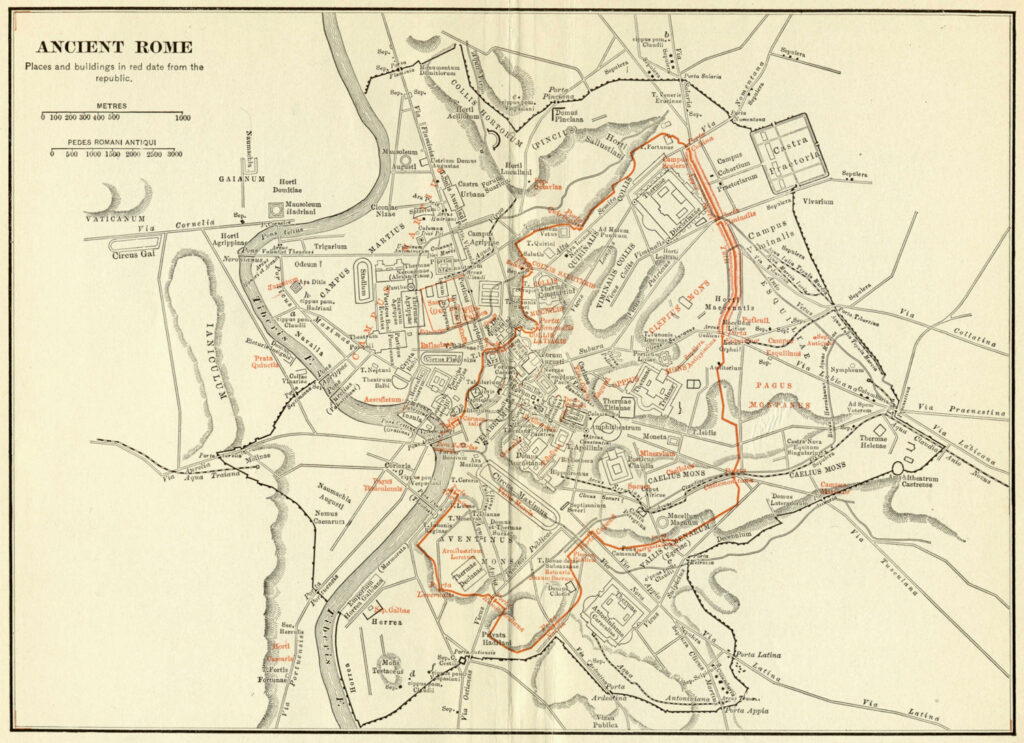
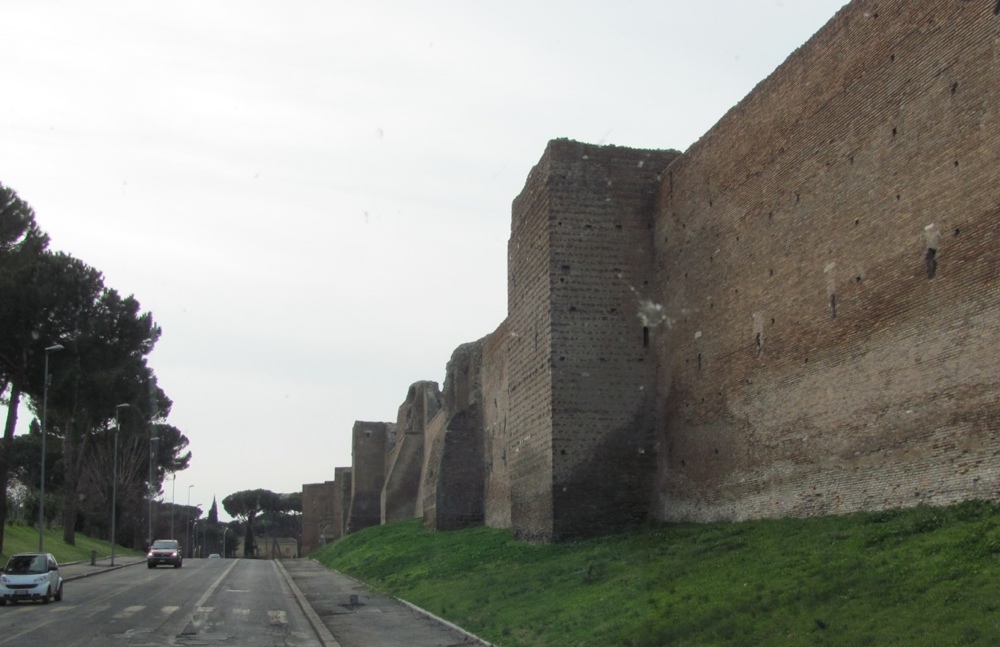









Thank you for these interesting details.
My pleasure!
I had no idea that so much Roman architecture could still be seen in that part of the world or that Roman roads (or at least the paths they created) are still being used. This is fascinating.
The Arch of Trajan is beautiful, too.
So many of the roads in Europe still fools the Roman pathways as they were often the most efficient way of travelling from A to B. And yes, the Romans left a monumental amount of ‘stuff’ behind them.